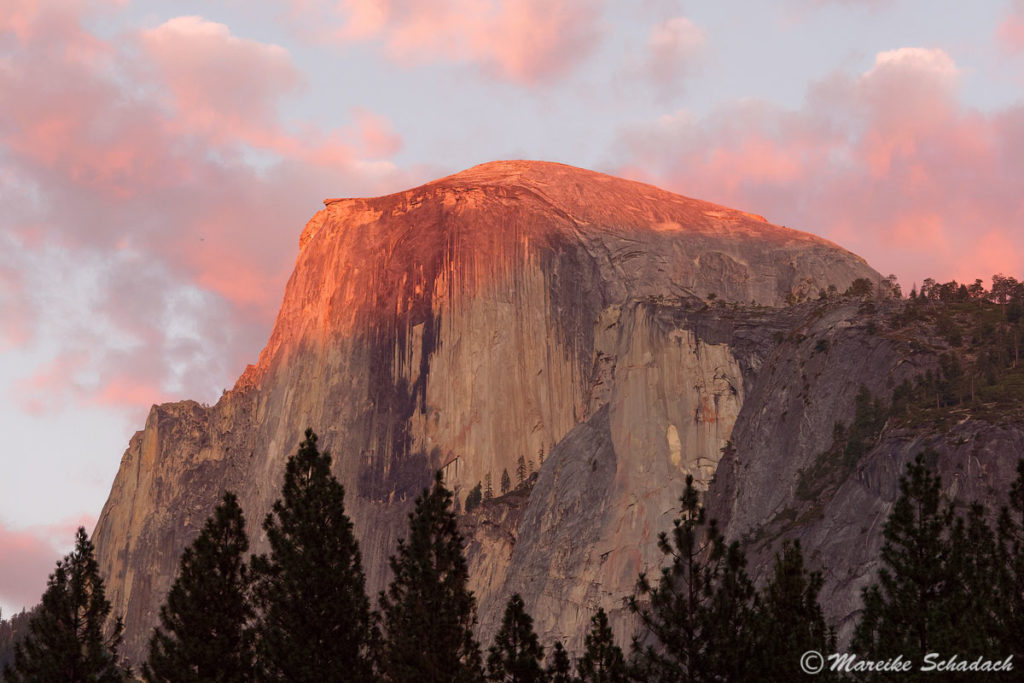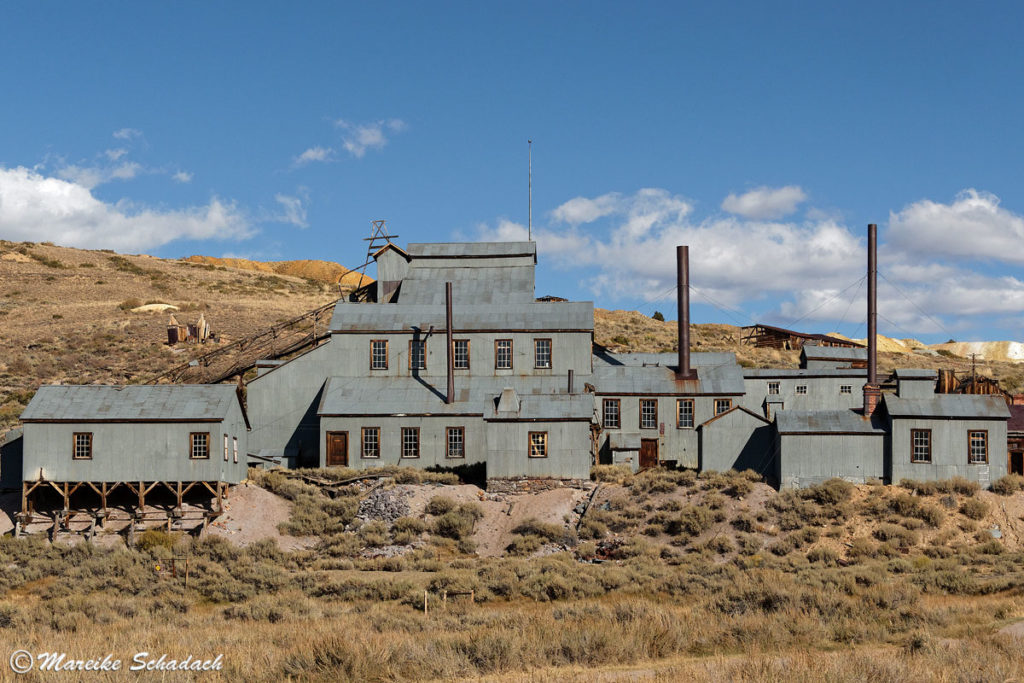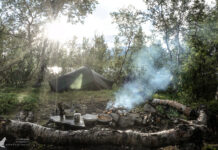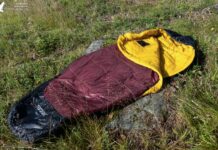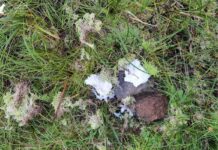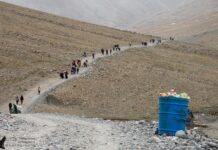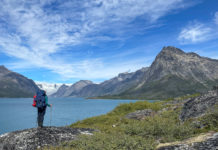California. The original forests exude a fascination of their own. They often seem enchanted and mystical and stories entwine around the forest. Some trees stand out and magically attract our gaze. Usually these are the largest and most beautifully grown trees. They make us look up and feel reverence for the power of nature. The Giant Sequoias in Mariposa Grove are such magical trees. They are up to 2,700 years old and almost 70 metres high. On a hike through Mariposa Grove in the south of Yosemite National Park you can see several of these fascinating trees. In my following article you will learn more about the Giant Sequoias and what possibilities you have to experience these trees.
Unassigned, unpaid advertising. The article contains affiliate links.
Table of Contents and Quick Navigation
Mariposa Grove in Yosemite National Park
Interesting Facts about the Giant Sequoias in Mariposa Grove
Photo-Tips
Hiking Trails through Mariposa Grove
On the Grizzly Giant Loop Trail through the Mariposa Grove
Getting there
Mariposa Grove in Yosemite National Park
The Mariposa Grove of Giant Sequoias, located in the south of the Yosemite National Park, is the largest sequoia grove in Yosemite. There are over 500 full-grown sequoia trees.
The grove was discovered in 1857 by Galen Clark and Milton Mann and was given the name "Mariposa Grove". In 1864, President Lincoln signed laws to protect Mariposa Grove and Yosemite Valley for public use and recreation. This groundbreaking law has an important place in the history of the USA and was also the root of the national park idea. It was the first time in history that areas were protected for future generations. Mariposa Grove was finally added to the existing Yosemite National Park in 1906 and is a popular destination within the National Park.
In 2016, as part of a major restoration project, the existing asphalt roads were rebuilt into dirt roads and trails and the grove regained a more natural appearance.
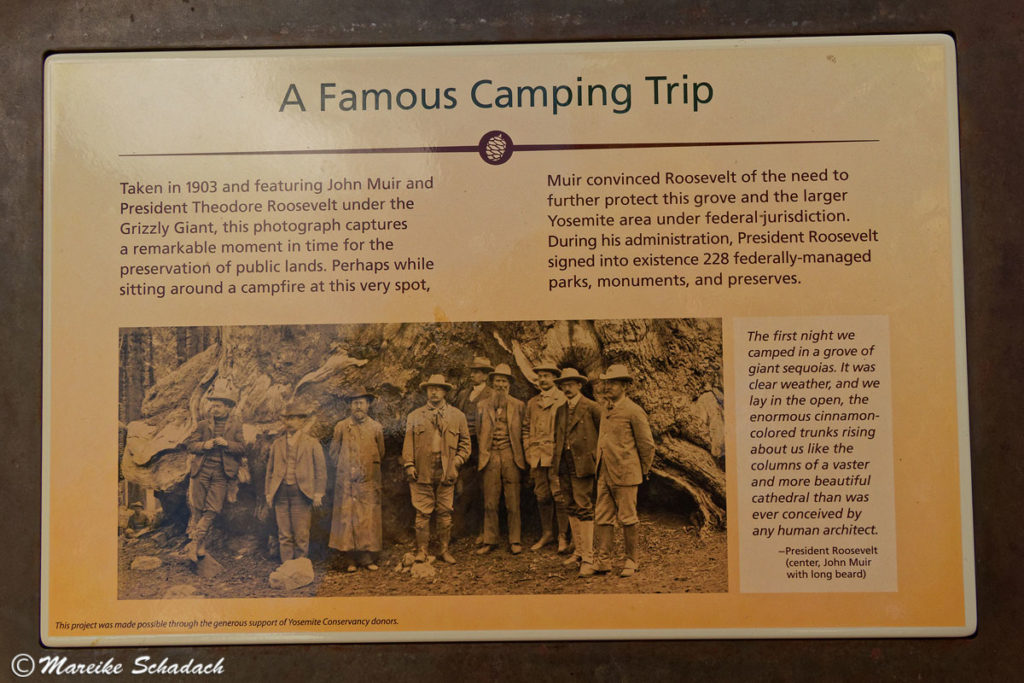
Interesting Facts about the Giant Sequoias in Mariposa Grove
The Giant Sequoias are an evergreen tree species. They can reach a height of up to 95 metres and a trunk diameter of up to 17 metres. Their natural range lies on the western slopes of the Sierra Nevada at an altitude between 1,350 and 2,500 metres. There the giant sequoia trees grow in groves, the so-called "Groves".
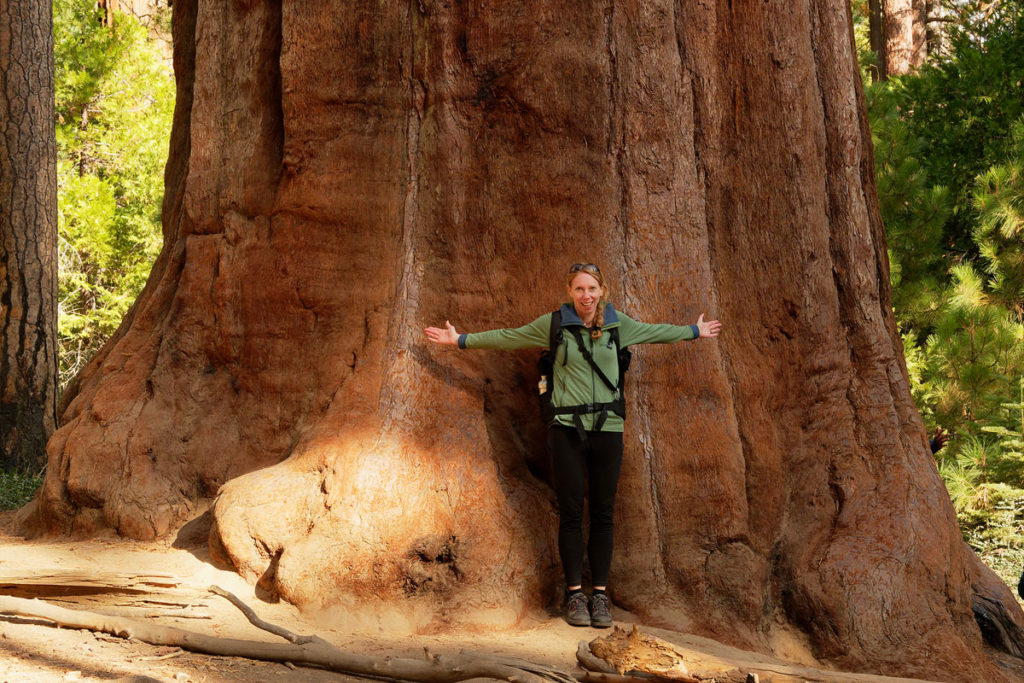
The Giant Sequoias can live for several thousand years and are therefore among the oldest living organisms on earth.
Their thick, fibrous bark protects the trees from fires, which are common in the dry forests of the Sierra Nevada. Many old trees therefore show traces of fires. However, if the tree is not too badly damaged, these scars can heal again. Another special feature of giant sequoia trees is that the cones only open after a forest fire. Now that many competing trees and plants have been burnt, the seeds can germinate undisturbed in the nutrient-rich ash layer.


However, the giant sequoia trees cannot only survive fire and lightning strikes. They even have their own natural defenses against insects and fungi.
In California's early history, many giant trees were felled, tunnels were built through tree trunks, and roots were damaged in the construction of roads. Nowadays, only two-thirds of the original population has survived and the giant sequoia is threatened with extinction in its natural range. For this reason, most of the Groves are protected. The Giant Sequoias are also affected by air pollution and climate change.
Photo-Tips
It is difficult to photograph the size and grace of the giant sequoia trees. Often the sequoia trees are surrounded by smaller trees and it is rare to have a good view of an entire tree. One possibility is to stand close to the trunk of the tree and then photograph up into the treetop with a wide-angle lens.
It is best to photograph the giant sequoia trees on cloudy days or when they are in the shade. Then the difference in contrast is not quite as high. Especially beautiful photos with a mystical charisma can succeed in fog. But also the light in the late afternoon can set the trees well in scene.
Hiking trails to the Giant Sequoias in Mariposa Grove
A hike through the Mariposa Grove is a very special experience. The huge sequoia trees make you look up in awe again and again. Information boards also provide information about special trees and the ecology of the forest.
You can get to know Mariposa Grove on various hiking trails. You can choose between a short walk or a half-day hike. We have chosen the Grizzly Giant Loop Trail, because here you can see most of the Giant Sequoias on a manageable route.
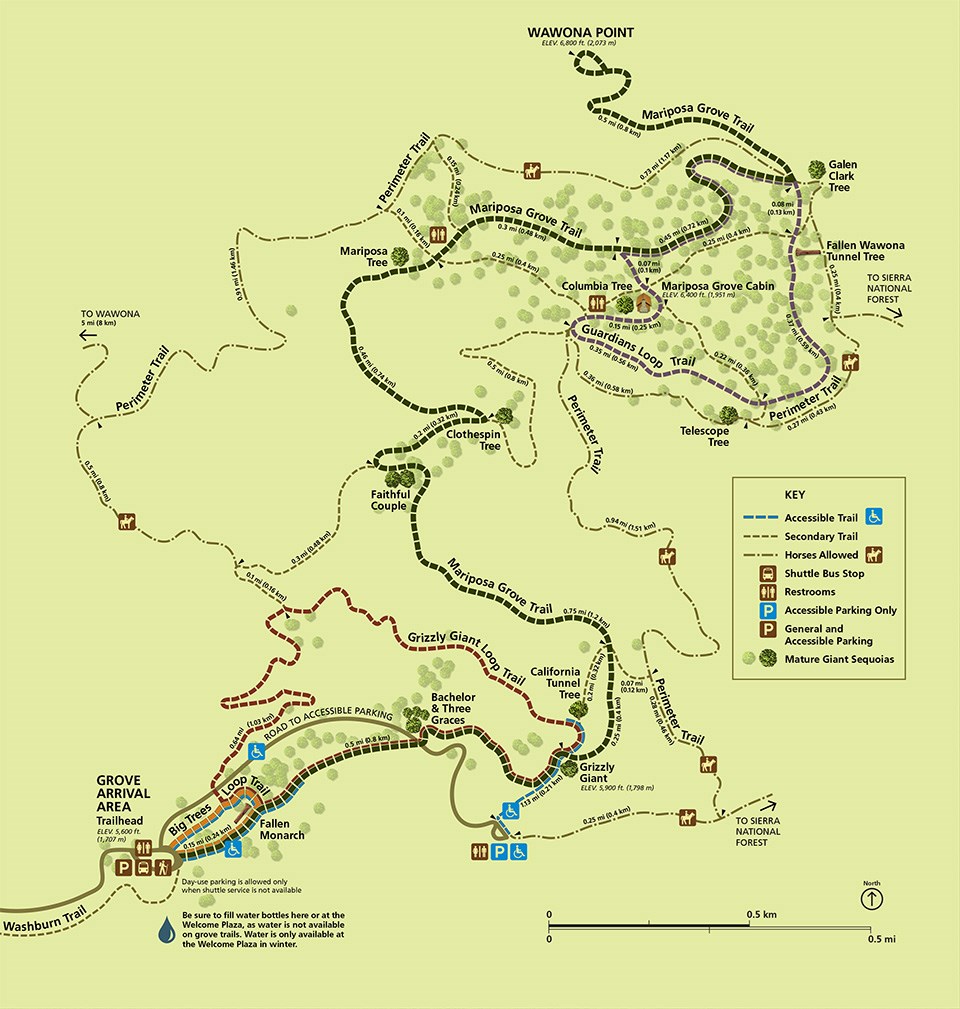
Source: National Park Service Yosemite
The Big Trees Loop Trail (0.4 km) is an easy trail and takes about half an hour. Highlights are the Fallen Monarch and several information boards about the giant sequoia trees and forest ecology.
The Grizzly Giant Loop Trail (3.2 km; 91 hm) takes about an hour. Here you can see the following outstanding trees: Fallen Monarch, Bachelor, Three Graces, Grizzly Giant and California Tunnel Tree.
The longest trail is the Mariposa Grove Trail (11.3 km; 366 hm). It is a circular trail to the Wawona Point vantage point. During your walk you can see the Grizzly Giant Loop trees, the Falthful Couple and the Clothespine Tree.
The Guardians Loop Trail (10.5 km) branches off from the Mariposa Groove Trail. Here you can see the overturned Wawona Tunnel Tree, the Telescope Tree and the Mariposa Grove Cabin.

On the Grizzly Giant Loop Trail through the Mariposa Grove
On the Grizzly Giant Loop Trail you can see some of the most important giant sequoia trees of Mariposa Grove. Below you'll learn more about the trees and their history. "Fallen Monarch
"Fallen Monarch"
The "Fallen Monarch" is the first highlight on the circuit. It overturned about 300 years ago. Giant sequoia trees are resistant to rot due to the high proportion of tannins in their bark, which is why the Fallen Monarch is so well preserved. It will therefore take several centuries before the wood is completely decomposed.
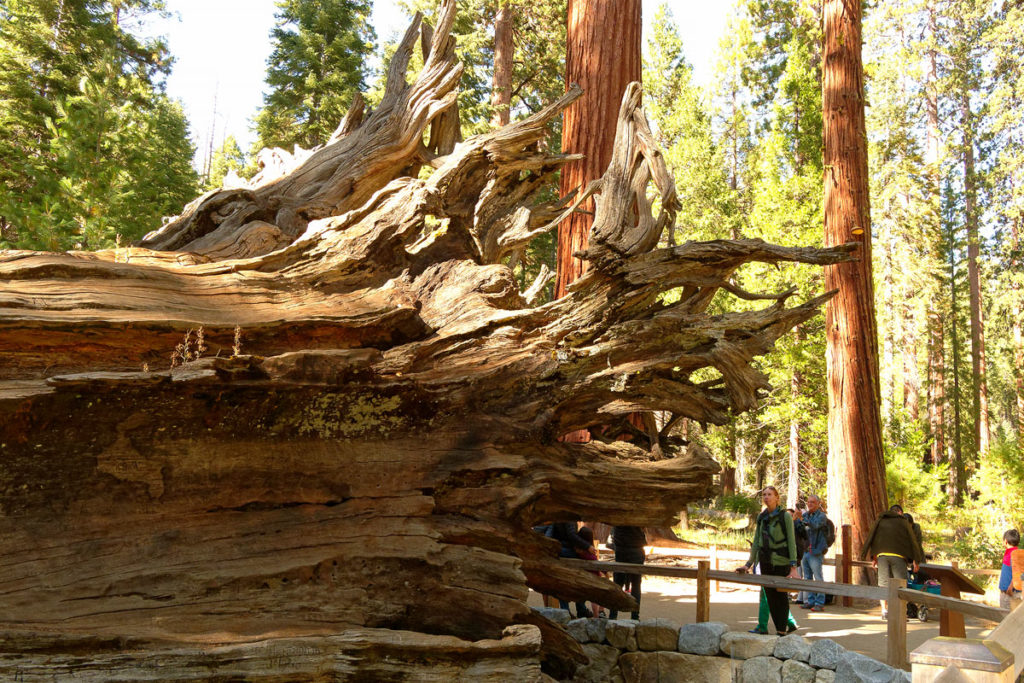
"Bachelor & Three Graces"
"Bachelor & Three Graces is a group of four sequoias. Three of them grow very much after each other. A fourth tree, on the other hand, grows a little further away. The roots of the four trees are so closely interwoven by this proximity that a falling tree would probably bring down the other trees.
“Grizzly Giant”
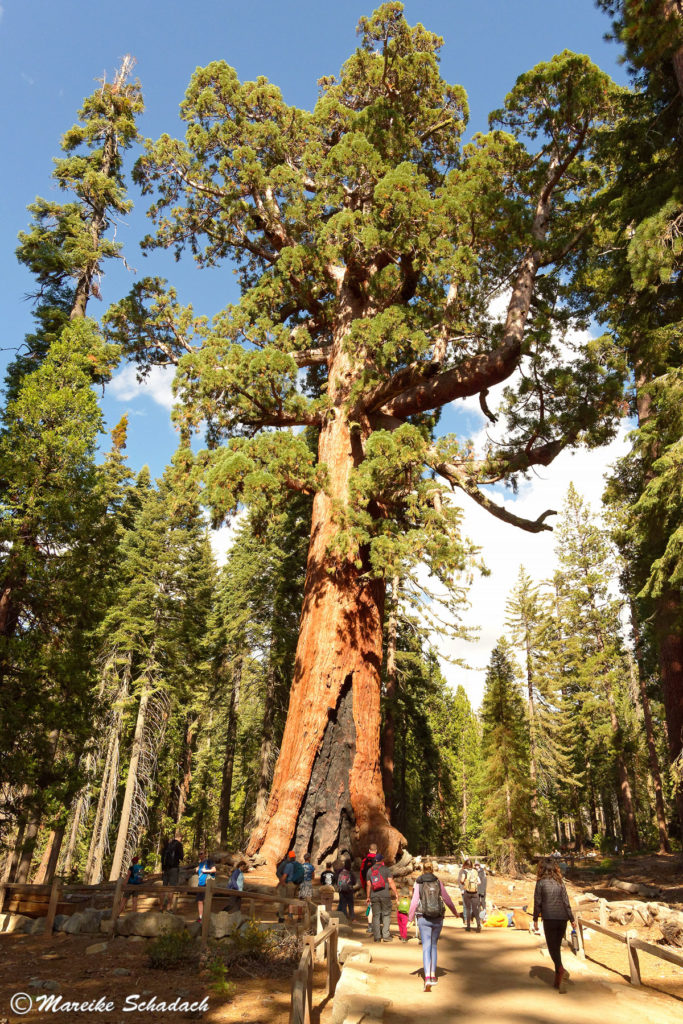
Der „Grizzly Giant“ ist mit 2.700 Jahren der älteste und zudem einer der bemerkenswertesten Bäume im Mariposa Grove. Er ist 63,7 Meter hoch und wird als der 25. größte Baum der Welt gezählt. Sein Stammdurchmesser beträgt 8,5 Meter. Der erste Ast des Grizzly Giant von der Basis aus hat einen Durchmesser von etwa 2 m. An seinem Stamm haben mehrere Feuer schwarze Stellen hinterlassen.
An interesting list of the thickest, highest and oldest sequoia trees in the world can be found here.
“California Tunnel Tree”
In 1895 a large tunnel was cut into a sequoia tree. In the following the tree was called "California Tunnel Tree". In an attempt to heal itself, the bark of the tree grew inward over the wounds. The Tunnel Tree has survived and is today an impressive example of the early tourism advertising of the National Park. The tunneled tree was a major attraction at Mariposa Grove and attracted many visitors to Yosemite National Park.
Before that, a tunnel was cut into another tree of Mariposa Grove. This was wide enough for horse-drawn carriages and automobiles to pass through. The "Wawona Tunnel Tree" was weakened so much that it fell during a storm in 1969.

Directions to Mariposa Grove
Shortly after the southern entrance to Yosemite National Park, Mariposa Grove Road branches off to the right from Wawona Road (Highway 41). This will take you to the Mariposa Grove Welcome Plaza visitor parking area with shop and toilets. From here a free shuttle bus will take you to the starting point of the hikes. Already during the bus ride you can see the first Giant Sequoias.
The shuttle bus runs every 10 minutes from 8 a.m. to 5 p.m., in summer even until 8 p.m.. Outside these times you can also drive your own car to Mariposa Grove. From November to May the road is closed and there is no shuttle bus. The sequoia trees can only be reached with skis or snowshoes.
Book Recommendation for California
You want to know where the journey goes? Then I can recommend these books* about California.
You can order these books at Amazon with a click on the pictures. If you buy a product via one of these affiliate links, I get a small commission and you help me to keep filling Fernweh-Motive with interesting articles. The product will not be more expensive for you.
Have you ever been to the Giant Sequoias in Mariposa Grove yourself? How did you like it? Do you have any questions about my article or suggestions? If so, please write me a comment!
Do you want to know when there are new articles on my blog? Then follow me on Facebook, Pinterest or Instagram. I would also be very happy if you share my article with your friends.




